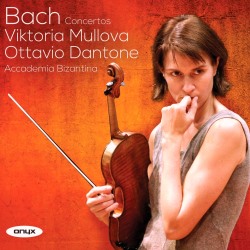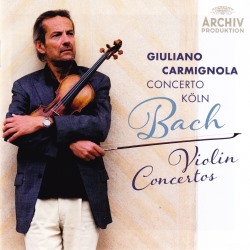

|
Johann Sebastian BACH (1685-1750)
Violin Concertos
Violin Concerto in E major, BWV 1042 [15.25]
Concerto for harpsichord in E major, BWV 1053 (arr. Dantone - violin in D) [19.39]
Violin Concerto in A minor, BWV 1041 [13.17]
Concerto for two harpsichords in C minor, BWV 1060 (arr. Dantone - violin and harpsichord) [13.05]
Viktoria Mullova (baroque violin)
Accademia Bizantina/Ottavio Dantone (harpsichord)
rec. Sala Oriani, Bagnacavallo, Ravenna, Italy, 1-5 December 2012
ONYX 4114 [60.31]
Johann Sebastian BACH
Violin Concertos
Violin Concerto in A minor, BWV 1041 [12.54]
Violin Concerto in E major, BWV 1042 [15.53]
Concerto for two violins, strings and continuo in D minor (Double Concerto), BWV 1043 [13.59]
Concerto for violin, strings and continuo in G minor, BWV 1056R [09.15]
(reconstr. Marco Serino after Harpsichord Concerto, BWV 1056)
Concerto for violin, strings and continuo in D minor, BWV 1052R [21.16]
(reconstr. Marco Serino after the Harpsichord Concerto, BWV 1052)
Concerto Köln/Giuliano Carmignola (baroque violin)
Mayumi Hiratsuka (leader, violin I, BWV 1043)
rec. Kammermusiksaal, Deutschlandfunk, Köln, Germany, July 2013
ARCHIV PRODUKTION 479 2695 [73.44]
These two separate releases of J.S. Bach Violin Concertos are played by two of the most renowned baroque violinists on the authentic instrument scene today. Not surprisingly Mullova and Carmignola have recorded together. I fondly recall their splendid 2007 collaboration with Vivaldi rarely heard Concertos for two violins on Archiv Produktion. Both are world class players and in the last couple of years I have seen them twice as soloists in concert performances in Dresden and Manchester. In fact the Onyx CD was given to me personally by Mullova during an interview in Dresden.
Bach’s violin concertos are products of his time in the employment of Prince Leopold of Saxony-Anhalt at Cöthen. It is thought that at least eight were composed with only three surviving. All the harpsichord concertos (with the exception of the Brandenburg Concerto No. 5) are considered likely to be arrangements made from the Cöthen concertos with only the harpsichord versions surviving. Mullova/Onyx and Carmignola/Archiv include on these releases violin concertos that are recent arrangements from the Cöthen harpsichord concertos.
The first recording has Mullova as soloist with the Ravenna based period instrument ensemble Accademia Bizantina directed by Ottavio Dantone from the harpsichord. Mullova and Dantone have chosen four concertos featuring the famous pair from Cöthen those in A minor (BWV 1041) and E major (BWV 1042) alongside two others that are transcriptions of concertos better known in other instrumentations. The duo felt it would be “interesting to focus on the practice of transcription” as it was common practice in Bach day to recycle his works for different instrumental combinations. Dantone arranged the harpsichord concerto BWV 1053 for violin in D and transcribed the concerto for two harpsichords BWV 1060 for violin and harpsichord.
Mullova is a consummate professional taught in the strict traditional Russian school now has one foot in the period instrument movement. Using a baroque violin fitted with gut strings and period bow her engaging playing is warm, fluid and highly expressive with her Romantic instincts relishing the long flowing lines. The opening movements are more measured in pace than those of Carmignola and she is not without a degree of indulgence in the slow movements playing with such beauty of tone. I would guess that the ensemble is around fifteen or so strong and it plays with glowing resilience. Mullova is provided with warm, reasonably clear sound; decently balanced too. There is enough room remaining on the disc to have accommodated another work; the Double Concerto, BWV 1043 would have been perfect. The booklet notes on this Onyx release are very short so those wanting more copious information will have to look elsewhere.
Next we come to Giuliano Carmignola who has selected five violin concertos which, like the Mullova/Dantone release, features the celebrated pair in A minor (BWV 1041) and E major (BWV 1042) plus the concerto for two violins in D minor (BWV 1043) also known as the double concerto. Carmignola, like Mullova/Dantone understands the role that the recycling of music played in Bach’s life. He was delighted to have the opportunity of working with his friend Marco Serino who has prepared reconstructions of two harpsichord concertos that are themselves arrangements of now lost Cöthen violin concertos. There is the harpsichord concerto (BWV 1056) appearing as a violin concerto in G minor and the harpsichord concerto (BWV 1052) arranged as a violin concerto in D minor.
A full-time performer of the authentic instrument school Carmignola’s compellingly assured playing is stunning from start to finish. These are fresh, crisply articulated and vibrantly expressive readings. There is nothing stuffy or stale about these period performances on a gut-strung baroque violin with period bow. His tempi are quicker than I had expected but every nuance seems perfect. The transparent string sound together with spare use of vibrato from Concerto Köln (thirteen strong) is confident and highly appealing, heightening the vital energy of the swiftly played Allegros. The playing of first violin, leader Mayumi Hiratsuka and of Carmignola is stunning in the double concerto, BWV 1043. This is irresistible with wonderful interplay in the Largo. The sound engineers are to be congratulated having secured very pleasing sound, vividly clear and justly balanced. This excellently presented Archiv Produktion release sports booklet notes that are pleasingly informative.
Of these two excellent period instrument performances that featuring Giuliano Carmignola is in a class of its own.
Michael Cookson
 |
 |
|
